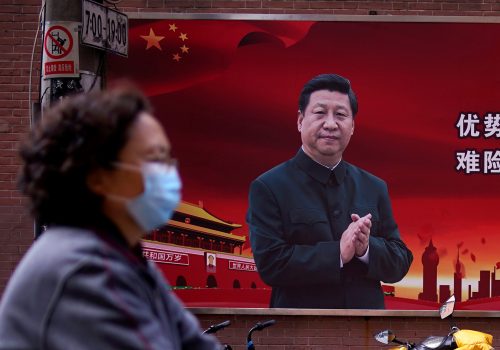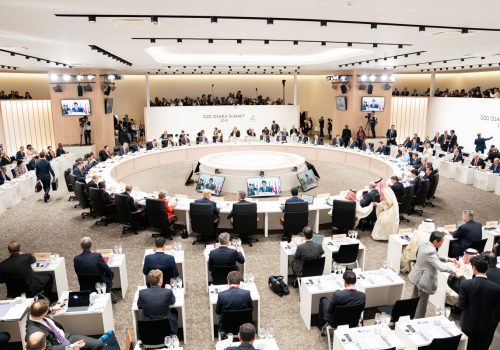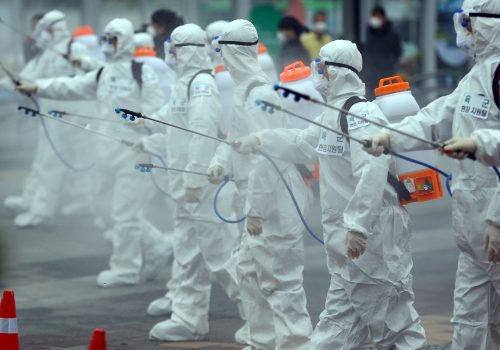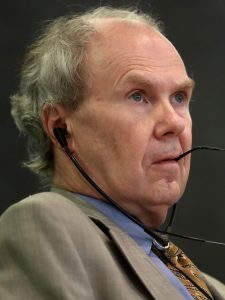Scenario 1: Great accelerator downwards
The post-COVID world: scenario 1
One of three scenarios sketching possible directions of the global system post-COVID-19. Because the crisis is still unfolding, these represent a preliminary look at the crisis’ geopolitical implications.
Download the full report using the button below.
The full text of the paper is split across the various articles linked below. Readers can browse in any order. To download a PDF version, use the button below.
The United States, Europe, and China all struggle to recover despite major fiscal and monetary efforts. The recovery stretches well into the 2020s, aggravated by the fact that it takes much longer for a vaccine to be developed than hoped for. Initially, there is an effort to replicate the post-2008-09 financial crisis period with summits of G7 and G20 leaders to map out a global recovery. But those summits soon break down, and Washington and Beijing revert to the usual blame game. A newly reelected Trump administration seeks to exploit the crisis by trying to wring concessions out of China on ending states’ subsidies to state-owned enterprises (SOEs), more market access for US firms, and guarantees against mandatory intellectual property/tech transfers for US firms doing business in China.
As long as China refuses, the United States maintains tariffs on Chinese exports and blocks new Chinese investments. Chinese leaders, for their part, will want to avoid adding to the debt burden with a huge stimulus package the way they did after the 2008 financial crisis. China’s stimulus efforts are smaller in scale.
Déjà vu in Europe
For the Europeans, there is a turn toward greater solidarity with a European Commission-administered rescue package that offers grants to hard-hit members. Nevertheless, the road back to growth stretches well into the 2020s. Despite the initial help from its fellow EU member states, Italy finds it difficult to stabilize after the devastating human and economic costs of the pandemic. Unstable politically and economically, Italians seek additional help that other EU member states are reluctant to provide without Italy undertaking major structural reforms. EU institutions are once again paralyzed as divisions deepen between north and south.
Europe is, furthermore, split over whether to back the United States in its “decoupling” threats against China. Many Europeans blame China for the pandemic, much like US public opinion, but an increasing number of countries in the south and east are grateful for Chinese help during the crisis and even afterwards, as new Chinese investments are made in those regions.
Worsening conditions in the developing world
The developing world is even more hard hit economically despite the fact that the worst forecasts of large-scale deaths in Africa and Latin America never come true. Death tolls resemble those in the West. The virus weakened as its moved south and the youthful populations—many of whom suffered minor symptoms— diminished the contagion. With the major economic powers hard hit, recovery is extremely difficult. Commodity prices remain low, hurting those developing countries that are dependent on the export of minerals, oil, etc. Chinese investments help, but CPC leaders are wary of providing much assistance largesse for fear the Chinese public is angered while conditions remain hard at home. Popular discontent against the CPC rises with China’s faltering domestic economy.
Depression and simmering global conflict
As during the Great Depression, there are many false starts, giving the illusion that the corner is about to be turned, justifying governments’ stubbornness in persevering with failing policies. Unlike in the 1930s, there is enough of a social safety net that discontent is contained despite slowly sinking standards of living in much of the world. The other is always to blame. Sino-American tensions escalate to an all-time high. The United States takes strong protectionist measures against China and Russia for their “disinformation,” deciding finally to erect a firewall against the two. Observers think the United States is preparing for a cyber war against China and Russia.
By the mid-2020s, deglobalization is speeding up, yielding slow economic growth everywhere. Poverty levels are rising in the developing world and there is the potential for open conflict between the United States and a China-Russia alliance.
Additional scenarios
View the full report
About the authors
Image: Foreign workers wearing protective face masks queue to use an ATM, following the outbreak of the coronavirus disease (COVID-19), in the Al Quoz industrial district of Dubai, United Arab Emirates, April 14, 2020. REUTERS/Christopher Pike




